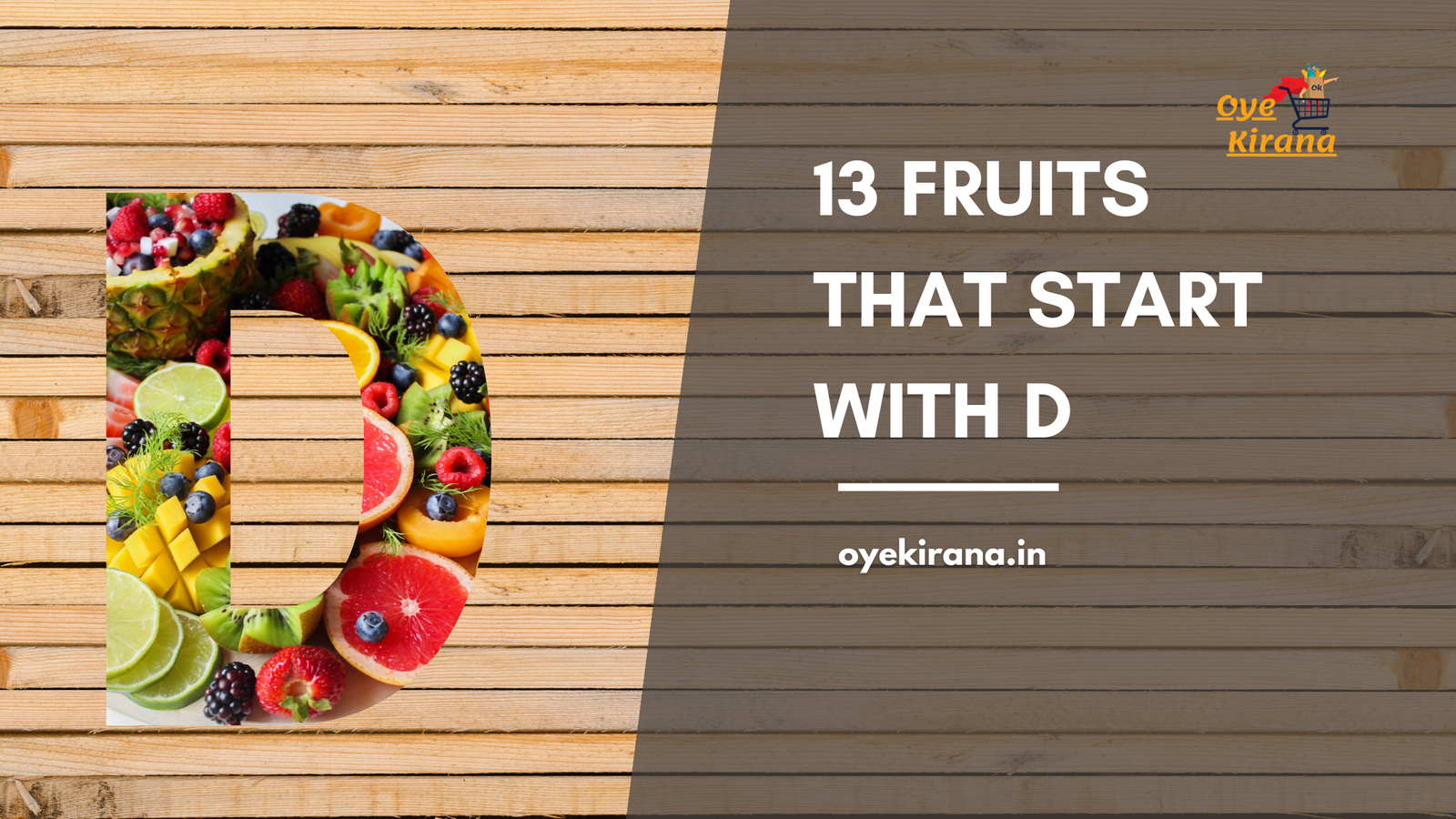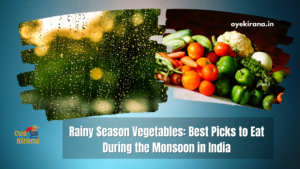Exploring fruits starting with D opens up a delightful world of flavors and health benefits. From adding sweetness to our snacks to providing essential vitamins, fruits are nature’s tasty treasures. In this blog, we’ll journey through the importance of including fruits in our daily diet, focusing on those that start with the letter ‘D’. Let’s dive in to learn about these delicious and nutritious options!
Top List Of Fruits Starting With D
Let’s explore some fascinating fruits that start with the letter D. These fruits not only bring diversity to our diets but also offer unique flavors and health benefits.
Durian (दुरियन)
- Origin and Description: Durian, known as the “King of Fruits,” originates from Southeast Asia and is recognized for its large size and strong odor.
- Nutritional Benefits: Rich in vitamin C, potassium, and dietary fiber, durian supports immune health and digestion.
- Culinary Uses: Enjoyed fresh or in desserts like ice cream and cakes, durian is a versatile culinary delight.
- Interesting Facts: Its distinctive smell has earned it bans in public places in some countries!
Dragon Fruit (ड्रैगन फ्रूट)
- Origin and Description: Native to Central and South America, dragon fruit is known for its vibrant pink or yellow skin and speckled flesh.
- Nutritional Benefits: High in antioxidants and vitamin C, dragon fruit promotes skin health and boosts immunity.
- Culinary Uses: Used in smoothies, salads, and jams, dragon fruit adds a refreshing sweetness.
- Interesting Facts: Also called pitaya, dragon fruit blooms from night-blooming cacti.
Date (खजूर – Khajur)
- Origin and Description: Dates grow on date palm trees and have a sweet, chewy texture with a rich caramel-like flavor.
- Nutritional Benefits: Packed with energy-boosting sugars, fiber, and essential minerals like potassium, dates aid in digestion and provide quick energy.
- Culinary Uses: Eaten fresh, dried, or in baking, dates are a staple in Middle Eastern cuisine and desserts worldwide.
- Interesting Facts: Dates have been cultivated for over 6,000 years and play a significant role in traditional Ramadan meals.
Damson (डैमसन)
- Origin and Description: Damsons are small, tart plums that thrive in Europe and are prized for their deep purple skin and tangy flesh.
- Nutritional Benefits: Rich in antioxidants and vitamins A and C, damsons support eye health and immune function.
- Culinary Uses: Used in jams, sauces, and desserts, damsons add a zesty flavor to culinary creations.
- Interesting Facts: The damson tree is often planted in hedgerows and has a long history in British orchards.
Dekopon (डेकोपॉन)
- Origin and Description: Originating from Japan, dekopon is a seedless citrus fruit known for its sweet, juicy segments and easy-to-peel skin.
- Nutritional Benefits: High in vitamin C and antioxidants, dekopon supports heart health and boosts collagen production.
- Culinary Uses: Enjoyed fresh or juiced, dekopon is a popular winter fruit in Japan and increasingly popular worldwide.
- Interesting Facts: Dekopon is also known as “Sumo Citrus” due to its large size and bumpy appearance.
Desert Lime (डेजर्ट लाइम)
- Origin and Description: Desert lime is a citrus fruit native to Australia, known for its small size and tangy flavor reminiscent of regular limes.
- Nutritional Benefits: Rich in vitamin C and antioxidants, desert lime supports immune function and skin health.
- Culinary Uses: Used in sauces, desserts, and beverages, desert lime adds a refreshing citrus twist to dishes.
- Interesting Facts: Aboriginal Australians have traditionally used desert lime for its medicinal properties and as a food source.
Davidson’s Plum (डेविडसन का आलूबुखारा)
- Origin and Description: Native to Australia, Davidson’s plum is a deep purple fruit with a tart flavor and is highly valued for its antioxidant properties.
- Nutritional Benefits: High in anthocyanins and vitamin E, Davidson’s plum helps combat oxidative stress and supports heart health.
- Culinary Uses: Used in jams, sauces, and desserts, Davidson’s plum adds a unique tanginess to culinary creations.
- Interesting Facts: The fruit is named after Queensland botanist and explorer David Davidson, who first documented it in the 19th century.
Dewberry (ड्यूबेरी)
- Origin and Description: Dewberries are small, sweet berries closely related to blackberries, known for their juicy texture and dark purple color.
- Nutritional Benefits: High in fiber, vitamins C and K, and antioxidants, dewberries promote digestive health and strengthen bones.
- Culinary Uses: Eaten fresh, in jams, or baked into pies, dewberries are a versatile ingredient in desserts and preserves.
- Interesting Facts: Dewberries grow wild in many parts of Europe and North America and are enjoyed by foragers and wildlife alike.
Duku (डुकू)
- Origin and Description: Duku, also known as langsat, is a tropical fruit native to Southeast Asia, with a sweet, tangy flavor and thin, yellowish skin.
- Nutritional Benefits: Rich in vitamin C, antioxidants, and dietary fiber, duku supports immune function and digestive health.
- Culinary Uses: Eaten fresh or used in desserts and preserves, duku is popular in Malaysian and Indonesian cuisine.
- Interesting Facts: Duku trees are often grown in home gardens and orchards throughout Southeast Asia for their delicious fruit and ornamental value.
Double Coconut (डबल नारियल)
- Origin and Description: The double coconut, or coco de mer, is a rare palm tree native to the Seychelles, known for producing the world’s largest seed.
- Nutritional Benefits: Rich in healthy fats and minerals like potassium and magnesium, double coconut seeds are nutritious but not typically eaten.
- Culinary Uses: While not edible in the traditional sense, the seeds have cultural significance and are sometimes carved into ornaments.
- Interesting Facts: The double coconut palm’s seed can weigh up to 30 kilograms (66 pounds) and is prized for its unique shape and appearance.
Dodder Laurel (डॉडर लॉरेल)
- Origin and Description: Dodder laurel, also known as laurel dodder, is a parasitic plant that grows on laurel and other trees, producing small, berry-like fruits.
- Nutritional Benefits: The fruits of dodder laurel are not typically consumed due to their parasitic nature and toxicity in some species.
- Culinary Uses: Not applicable for culinary purposes; dodder laurel is mainly studied for its role as a parasite in ecosystems.
- Interesting Facts: Dodder laurel is intriguing for its unique method of obtaining nutrients from host plants and its adaptation to various environments.
Desert Quandong (डेजर्ट क्वांडोंग)
- Origin and Description: Desert quandong, or native peach, is a fruit-bearing tree native to Australia’s arid regions, known for its tart, tangy fruit.
- Nutritional Benefits: High in vitamin C, antioxidants, and essential minerals, desert quandong supports immune health and skin rejuvenation.
- Culinary Uses: Used in jams, sauces, and desserts, desert quandong adds a distinct flavor to traditional Australian dishes.
- Interesting Facts: Aboriginal Australians have used desert quandong for thousands of years, both as a food source and for medicinal purposes.
Dangleberry (डैंगलबेरी)
- Origin and Description: Dangleberries are small, dark purple berries native to Europe, closely related to blueberries and known for their sweet, juicy flavor.
- Nutritional Benefits: High in antioxidants, vitamins, and dietary fiber, dangleberries support heart health and cognitive function.
- Culinary Uses: Eaten fresh, in jams, or baked into pies, dangleberries are a versatile ingredient in various European cuisines.
- Interesting Facts: Dangleberries grow wild in forests and are cherished by foragers for their delicious taste and nutritional benefits.
These fruits starting with ‘D’ showcase the diversity of nature’s bounty, each offering unique flavors, nutritional benefits, and cultural significance. Incorporating these fruits into our diets not only adds excitement to our meals but also supports our overall health and well-being.
Conclusion
Exploring fruits starting with ‘D’ has been a journey of discovery and flavor. From the unique sweetness of durian to the antioxidant-rich Davidson’s plum, each fruit offers distinct tastes and health benefits. Whether enjoyed fresh or in culinary dishes, these fruits enrich our diets with essential nutrients like vitamins, fiber, and antioxidants.
Incorporating a variety of ‘D’ fruits into our meals not only adds diversity but also supports overall health—from boosting immunity to promoting heart health. Next time you shop, consider adding these nutritious options to your basket for a flavorful and beneficial addition to your diet. Just as fascinating as fruits starting with d, fruits starting with R also offer a wealth of nutrients and flavors.
Did you find a new favorite among these ‘D’ fruits? Share your thoughts in the comments below and spread the love for healthy eating by liking and sharing this blog with friends. Happy exploring and tasting!




